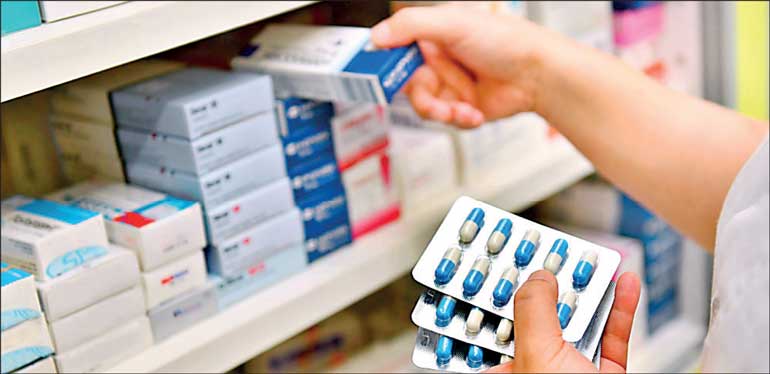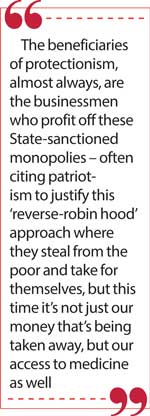Saturday Oct 18, 2025
Saturday Oct 18, 2025
Friday, 17 October 2025 00:24 - - {{hitsCtrl.values.hits}}

But is it as easy to turn a blind eye when it’s a medicinal shortage in question?
 As a Sri Lankan consumer, do you feel like you’re getting value for money when you make a purchase? The same Samsung 55” 4K LED Smart-TV priced at Rs. 324,999 at Unity Plaza can be bought on Amazon in America for around Rs. 110,500. Mind you, the federal minimum wage in America is $ 7.25 (Rs. 2,200 approx.) per hour while the (recently updated) national minimum wage in Sri Lanka is Rs. 1,800 per day.
As a Sri Lankan consumer, do you feel like you’re getting value for money when you make a purchase? The same Samsung 55” 4K LED Smart-TV priced at Rs. 324,999 at Unity Plaza can be bought on Amazon in America for around Rs. 110,500. Mind you, the federal minimum wage in America is $ 7.25 (Rs. 2,200 approx.) per hour while the (recently updated) national minimum wage in Sri Lanka is Rs. 1,800 per day.
Putting things into perspective, a minimum wage worker in the US earns more per hour than their Sri Lankan counterpart does per day and can still buy three TVs in America for the cost of one in Sri Lanka! And what if it’s only going to get worse?
On 25 March 2025 at a ‘Consultation and Validation Workshop’ held at Galle Face Hotel, a strategy report commissioned by the Asia Development Bank (ADB) titled ‘Strategy for Promoting Local Production of Pharmaceutical Formulations in Sri Lanka’ was circulated (the ‘Report’).
At its core, this Report was a manifesto for economic protectionism and market isolationism cloaked in the guise of pharmaceutical self-sufficiency. Piggybacking on the fact that only 15% of Sri Lanka’s pharmaceutical requirement is met domestically, this report unabashedly advocated for restricting pharmaceutical imports not on the basis of product quality, price competitiveness or public health exigency, but solely to shield local manufacturers from fair competition. It also serves as an instruction manual to circumvent Sri Lanka’s obligations under several GATT articles.
Long-term repercussions not worth the trade-off
The ADB and the World Trade Organization (WTO) are no strangers to each other. On the one hand the ADB is working with the WTO to eliminate trade barriers. They even published an article titled ‘Why Penalising Imports is a Bad Idea’. The gist of which is that although penalising imports may yield short-term gains, the long-term repercussions are not worth the trade-off. But on the other hand, the ADB is also (on the verge of) endorsing protectionist strategies and advocating workarounds for WTO obligations.
Protectionist policies almost always hit the consumer the hardest. In America, the Bush administration imposed heavy tariffs on imported steel, which raised costs for downstream industries like automobiles and appliances, which led to loss of jobs, higher consumer prices and overall economic losses. India did the same with their ‘License Raj’ program (1947-1991) which created a captive market for companies like Hindustan Motors, Premier Padmini and Bajaj Auto through production licenses and import restrictions. The cost borne by the consumers in these cases went beyond fiscal – they had to endure outdated models, long waiting lists and high prices, because foreign competitors were barred.
Only after the 1991 liberalisation did things change when players like Maruti-Suzuki and Hyundai entered the market, pushing the local companies to either modernise or vanish (like Hindustan Motors eventually did).
Consumer endures higher prices for lower quality goods
 Energy is neither created nor destroyed, it can only be converted from one form to another. A similar principle applies here. The cost of cutting out imports and the cost of subsidising local production is not an expense that just disappears. It needs to be borne by someone, and 100% of the time, it ends up being the consumer who endures higher prices for often lower quality goods.
Energy is neither created nor destroyed, it can only be converted from one form to another. A similar principle applies here. The cost of cutting out imports and the cost of subsidising local production is not an expense that just disappears. It needs to be borne by someone, and 100% of the time, it ends up being the consumer who endures higher prices for often lower quality goods.
Sri Lanka’s current recovery under the IMF program and discipline with which reforms are being implemented has garnered international recognition and praise. But if the Government was to pivot towards protectionist policies it would run in direct contradiction of the IMF’s founding principles which align with trade liberalisation and dismantling barriers to trade. Such a shift would risk straining Sri Lanka’s relationship with the IMF on three fronts. First it would undermine program compliance, since protectionist measures clash with liberalisation and market-oriented reforms built into IMF conditionalities. Second, it would erode credibility and investor confidence. Finally, it would damage Sri Lanka’s international standing.
The beneficiaries of protectionism, almost always, are the businessmen who profit off these State-sanctioned monopolies – often citing patriotism to justify this ‘reverse-robin hood’ approach where they steal from the poor and take for themselves, but this time it’s not just our money that’s being taken away, but our access to medicine as well.
Protectionism and multi-national corporations (MNCs) get along about as well as the Indian and Pakistani cricket teams do right now. And any attempt at implementing these recommendations could see Sri Lanka being blacklisted globally. While America and India eventually undid the damage of their protectionism, the Sri Lankan pharmaceutical market isn’t lucrative enough to encourage a second chance from the MNCs we’d be severing ties with.
The report erroneously fails to consider the repercussions of its proposals and puts forward their suggestions in a hypothetical vacuum. The fallout from implementing this could very well result in a halt in R&D and innovation – which, in this age of ever evolving viruses, even with a (highly unlikely) domestic manufacturing industry is akin to taking a stick to a gunfight.
Sri Lanka has tried protectionist policies before (remember the rice shortage?). And sure, if you’re ‘patriotic’ (or foolish) enough, you may be willing to soldier through another shortage for a while, until we revert to status quo. But is it as easy to turn a blind eye when it’s a medicinal shortage in question? You can switch out rice for breadfruit or McDonalds for Burger King, but you can’t switch your sugar meds for ‘paspanguwa’ or heart meds for ‘asamodagam’, can you?
(The writer is an attorney-at-law and Junior Associate at LexAG).